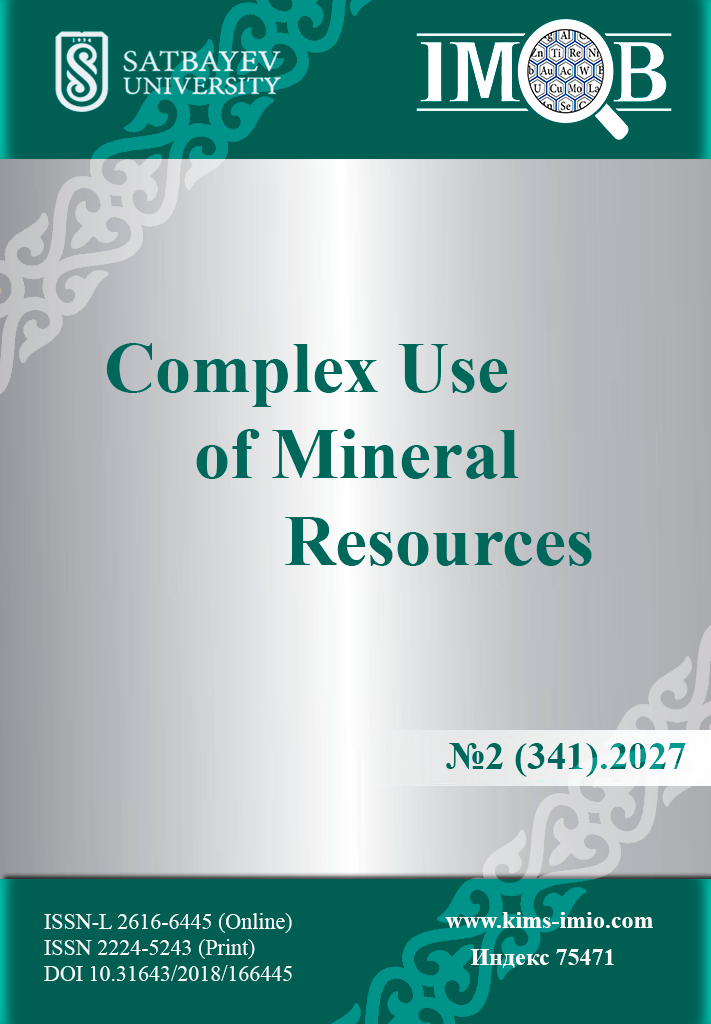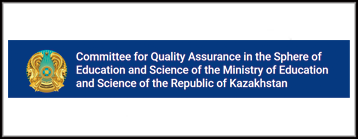Artificial graphite from Shubarkol coal obtained by sublimation of carbon atoms into the gas phase followed by desublimation into high-purity graphite
DOI:
https://doi.org/10.31643/2027/6445.15Keywords:
plasma, sublimation, desublimation, graphitization, carbon, graphite, separation, catalyst.Abstract
This article discusses a plasma-chemical method for producing high-purity graphite from an air suspension of low-ash coal particles from the Shubarkol deposit in Kazakhstan. The technological process is based on the ability of carbon to transform from a solid to a gaseous state, bypassing the liquid state. This means it sublimes at high temperatures and desublimes as the temperature of the gaseous medium in the reactor zone decreases. The use of a graphite catalyst allows for controlled formation of the graphitized material. Atomic carbon graphitization occurs over a wide temperature range. It was established that graphite obtained in high-temperature reactor zones is purer than graphite obtained in reactor zones close to 500°C. This feature of the graphitization process enables product classification by quality. The design of a reactor based on sublimation and desublimation processes for graphite production is discussed. The use of a high-frequency electromagnetic zone in the plasma-chemical reactor design allows for controlled graphitization of atomic carbon, intensifying desublimation processes over a graphite powder catalyst. The plasma-chemical apparatus design includes a dust collection system and carbon monoxide neutralization, which can occur due to variations in the component proportions in the feedstock, which includes carbon powder, graphite powder catalyst, and carbon dioxide. The developed apparatus can be used to produce a sorbent – thermochemically expanded graphite – from graphite by varying the operating mode. The aim of this research is to develop a plasma-chemical technology for producing graphite from coal based on sublimation and desublimation processes in a single reactor, with the separation of impurities during the graphitization of carbon atoms over a graphite catalyst.
Downloads
References
Saryglar ChA, Chysym RB. Main directions of coal processing. Fundamental research. 2018; 11(1):121-127.
Imash AA, Kaidar BB, Zhumatayev YeA, Smagulova GT. Puti kompleksnoy pererabotki ugley [Routes for integrated coal processing]. Goreniye i plazmokhimiya [Combustion and Plasma Chemistry]. 2021; 19:327-338. (In Russ). https://doi.org/10.18321/cpc471
Jung JC-Y, Sui Р-С. Zhang J. A review of recycling spent lithium-ion battery cathode materials using hydrometallurgical treatments. J Energy Storage. 2021; 35:102217.
Liu К, Yang S, Luo L, Pan Q, Zhang P, Huang Y, Zheng F, Wang H, Li Q. From spent graphite to recycle graphite anode for high-performance lithium-ion batteries and sodium ion batteries. Electrochim. Acta. 2020; 356:136856.
Yang K, Gong P, Tian Z, Lai Y, Li J. Recycling spent carbon cathode by a roasting method and its application in Li-ion batteries anodes. J Clean. Prod. 2020; 261:121090.
Xing W, Bai P, Li ZF, Yu RJ, Yan ZF, Lu GQ, Lu LM. Synthesis of ordered nanoporous carbon and its application in Li-ion battery. Electrochim. Acta. 2006; 51(22):4626-4633.
Paek S-M, Yoo E, Honma I. Enhanced Cyclic Performance and Lithium Storage Capacity of Sn02. Graphene Nanoporous Electrodes with Three-Dimensionally Delaminated Flexible Structure. Nano Lett. American Chemical Society. 2009; 9(1):72-75.
Guo P, Song H, Chen X. Electrochemical performance of graphene nanosheets as anode material for lithium-ion batteries. Electrochem. commun. 2009; 11(6):1320-1324.
Patent No. 20316. Method for producing thermally expanded graphite. Potapov AM, Protopopov AV, Assan AK. 25.08.2007.
Almasov N, Kurbanova B, Kuanyshbekov T, Akatan K, Kabdrakhmanova S, & Aimaganbetov K. Study of the structure and electrical properties of graphene oxide (GO) and graphene oxide+nanocellulose (GO+NC). Kompleksnoe Ispolzovanie Mineralnogo Syra = Complex Use of Mineral Resources. 2024; 329(2):103–109. https://doi.org/10.31643/2024/6445.21
Fialkov AS. Protsessy i oborudovaniye proizvodstva poroshkovykh uglegrafitovykh materialov [Processes and equipment for the production of powdered carbon-graphite materials]. M.: Aspect Press. 2007, 687. (In Russ).
Seleznev AN. Uglerodnoye syr'ye dlya elektrodnoy promyshlennosti [Carbon raw materials for the electrode industry]. M.: Profizdat. 2000, 256. (In Russ).
Aladekomo J, Bragg R. Structural transformations induced in graphite by grinding: analysis of 002 X-Ray diffraction line profiles. Carbon. 1990; 28(6):897-906.
Samoilov VM. Polucheniye melkozernistykh uglerodnykh napolniteley i razrabotka tekhnologii polucheniya melkozernistykh grafitov na ikh osnove [Production of fine-grained carbon fillers and development of technology for the production of fine-grained graphites based on them] diss. ... doc. of technical sciences. M. 2006. 358.
Fedorov VV, Shorshorov MKh, Khakimova DK. Stroyeniye uglerodnykh materialov na raznykh urovnyakh organizatsii [Structure of carbon materials at different levels of organization]. Uglerod i yego vzaimodeystviye s metallami [Carbon and its interaction with metals]. collection of scientific papers. M.: Metallurgy. 1978, 20-21. (In Russ).
Maire J, Merring J. Graphitization of soft carbons. Chemistry and physics of carbon. 1970; 6:125-190.
Pat. 2256610 Russian Federation, IPC C01B31/04. Sposob polucheniya vysokoplotnykh melkozernistykh uglegrafitovykh materialov [Method for producing high-density fine-grained carbon-graphite materials]. A. Sviridov, A.N. Seleznev, S.A. Podkopaev, et al. Publ. 27.02.05, 1.
Novak YuV, Perkova GA, Kuteinikov AF. Udaleniye primesey pri formirovanii struktury grafita [Removal of impurities during graphite structure formation]. Konstruktsionnyye materialy na osnove grafita: sbornik nauchnykh trudov [Graphite-based structural materials: collection of scientific papers]. M.: Metallurgy. 1979; 14:35-40. (In Russ).
Bragg R. Lattice parameters of metastable phases of graphite. Proceedings of International Carbon Conference. 1992, 192-193.
Mokhova NN, Molotok NP. Vliyaniye dispersnosti tonkogo pomola na formirovaniye poristoy struktury i svoystva uglegrafitovykh materialov [Influence of fine grinding dispersion on the formation of porous structure and properties of carbon-graphite materials]. Proizvodstvo uglegrafitovykh materialov: sbornik nauchnykh trudov [Production of carbon-graphite materials: collection of scientific papers]. M.: NIIGrafit, GosNIIEP. 1980, 24-31. (In Russ).
Pat. 4293533 United States, Int. C01B31/00; C01B31/02; C01B31/04. Method for producing solid carbon material having high flexural strength. K. Asano, H. Tamura, Y. Nezu, T. Saito, Y. Kawai. Publ. 06.10.1981, 8.
Pat. 2257341 Russian Federation, IPC С01В31/04. Sposob polucheniya melkozernistogo grafita [Method for producing fine-grained graphite]. V.M. Samoilov, B.G. Ostronov, I.A. Bubnenkov et al. Publ. 27.07.2005, 5. (In Russ).
Pat. 4089934 USA, Int. C01B3102; CO IB 3104. Process for preparing carbon products. O. Akiyoshi, A. Mukai, Y. Miwa. Publ. 16.05.78б 8.
Pat. 0575748 EP, Int. C04B35/52. Self-adhesive carbonaceous grains and high-density carbon artifacts derived therefrom. I. Machida, R. Fujiura, T. Kojima, H. Sakamoto. Publ. 29.12.93, 13.
Pat. 0657400 EP, Int. C04B35/52. Process for producing high-density and high-strength carbon artifacts from self-adhesive carbonaceous grains. R. Fujiura. Publ. 31.03.1999, 11.
Safonov AA, Mausymbayeva AD, Portnov VS, et al. Analysis of the possible use of coals from the Shubarkol deposit in the smelting of technical silicon. Coal. 2019; 2:68-72.
Downloads
Published
How to Cite
Issue
Section
License
Copyright (c) 2025 Zh.T. Aimenov, A.V. Protopopov, E.A. Suleimenov, A.A. Saipov, M.A. Protopopov; A.Zh. Merekeyeva

This work is licensed under a Creative Commons Attribution 4.0 International License.


























